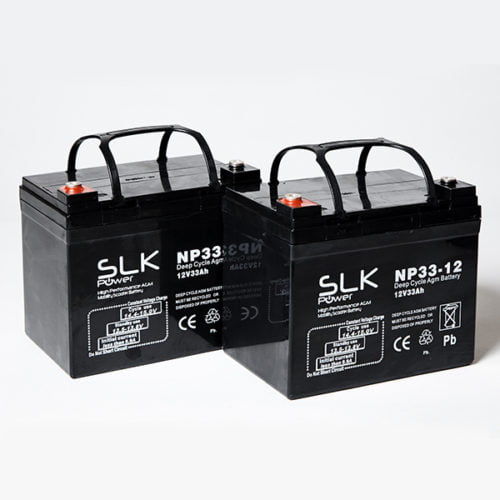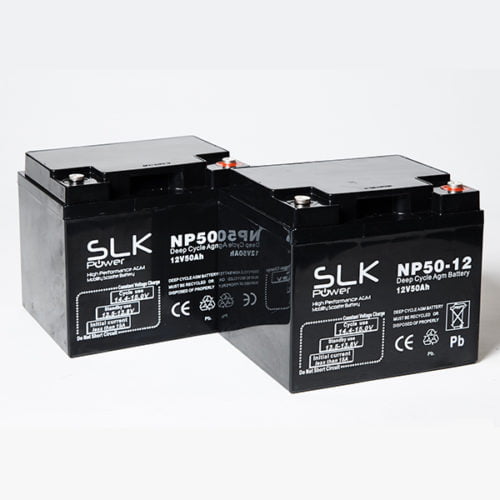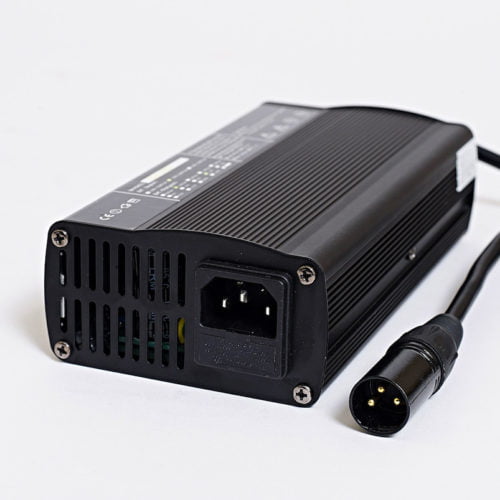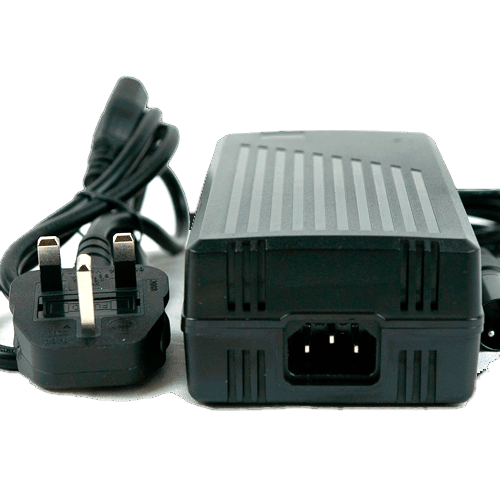AGM vs GEL vs Lithium Mobility Scooter Batteries
There are 3 types of batteries for mobility scooters.
One of the biggest benefits of AGM batteries is they are cheap. Why? It simply comes down to the fact that they are the cheapest to produce. They are designed for light use and SLK warranty the batteries for 1 year.
Gel batteries a deep cycle durability that allows you discharge them up to 90% and still get a much better cycle life compared to AGM batteries.
Lithium batteries discharge evenly over their cycle unlike lead acid, AGM or Gel mobility batteries. You will not only get at least 2-3 times more range but your scooter will not slow down and labour up hills any more. The speed of your scooter will not be altered by Lithium batteries, it will just be more even and consistent.
Thanks to the built in battery management system (BMS) lithium batteries stay protected even when your charge dropdown to zero. This helps keep the life expectancy of the battery at its peak.
AGM
- Non Spillable sealed leac acid battery
- Aircraft Safe
- Low Cost
- Designed for light use
- 1 Year Warranty
Lithium
- 75% Lighter than standard batteries
- Out performs in distance and longevity
- Designed for Heavy use
- Value is in reliability and lifespan
- Life span could exceed 5 years
- 3 Year Warranty
- Run to Zero Protection (BMS)
Gel
- Non Spillable sealed leac acid battery
- Aircraft Safe
- Premium Battery
- Slower Discharge Rate
- Endures more charge cycles
- Performs well under extreme weather conditions
- Designed for medium use
- 1 Year Warranty
Platinum Gel
- Non Spillable sealed leac acid battery
- Aircraft Safe
- Premium Battery
- Slower Discharge Rate
- Endures more charge cycles
- Performs well under extreme weather conditions
- Designed for medium use
- 1 Year Warranty
- Heavier Duty Cells
- Heavier Duty Plates
- Longer Distance
AGM Batteries FAQ's
Frequent sulfation, caused by inadequate charging or discharging, can lead to reduced battery capacity. Consider optimizing your charging habits and ensuring proper maintenance to prevent sulfation.
Proper charging techniques, avoiding deep discharges, and storing the battery in a cool, dry place can help extend its lifespan. Regular maintenance, such as checking electrolyte levels, also contributes to longevity.
Lead-acid batteries have higher self-discharge rates compared to other battery types. Extended periods of non-use can lead to self-discharge, causing the battery to lose its charge. Consider using a battery maintainer or periodically charging the battery to prevent this issue.
Lead-acid batteries generally have a limited lifespan of around 200-300 charge-discharge cycles
GEL Batteries FAQ's
A GEL battery is a type of valve-regulated lead-acid (VRLA) battery that uses a gel electrolyte. This gel electrolyte prevents the acid from flowing freely, making the battery spill-proof and maintenance-free. Unlike flooded lead-acid batteries, GEL batteries do not require regular electrolyte checks or topping up.
GEL batteries offer several advantages, including enhanced safety due to their spill-proof design. They also have a longer lifespan compared to traditional flooded lead-acid batteries, as they are less prone to sulfation. Furthermore, GEL batteries are well-suited for deep-cycle applications and can withstand frequent deep discharges.
It is recommended to use a charger specifically designed for GEL batteries. These chargers are programmed to meet the GEL battery’s unique charging requirements, including lower voltage thresholds and temperature compensation. Using a regular lead-acid charger may overcharge or damage the GEL battery.
GEL batteries are generally maintenance-free, but a few maintenance practices can help optimize their performance. It is essential to keep the battery terminals clean and free from corrosion. Monitoring the battery voltage periodically and recharging it when the voltage drops below a certain threshold can also help maintain its health.
GEL batteries have good temperature tolerance and can be used in a wide range of weather conditions. They perform well both in extreme cold and hot temperatures. However, extremely high temperatures can affect their overall lifespan, so it’s advisable to avoid prolonged exposure to excessive heat.
The lifespan of a GEL battery can vary depending on factors such as usage patterns, charging practices, and environmental conditions. On average, GEL batteries can last anywhere from 18 Months to 3 years. Proper maintenance and adherence to manufacturer guidelines can help maximize their longevity.
In most cases, GEL batteries are compatible with mobility scooters that use lead-acid batteries. However, it’s crucial to ensure that the specifications and size of the GEL battery match the requirements of your scooter. It’s recommended to consult the manufacturer or a knowledgeable technician to determine the compatibility and make any necessary modifications to the wiring or charging system.
Platinum GEL Batteries FAQ's
Both Gel and Gel Platinum batteries share common characteristics, being non-spillable sealed lead-acid batteries deemed aircraft safe, premium in quality, with a slower discharge rate, endurance for more charge cycles, and adaptability to extreme weather conditions. Designed for medium use, both come with a 1-year warranty.
The Gel Platinum batteries, however, stand out with heavier-duty cells and plates, offering enhanced durability and resilience. This translates to a longer distance coverage, making them an ideal choice for applications where a robust and long-lasting power source is essential. The heavier-duty components contribute to increased capacity, power output, and an extended cycle life, making Gel Platinum batteries suitable for more demanding usage scenarios.
Heavier-duty cells in GEL batteries for mobility scooters provide several benefits similar to those of heavier-duty plates. Here are some advantages associated with heavier-duty cells:
Increased Capacity: Heavier-duty cells often have a higher capacity, allowing the battery to store more energy. This results in an extended range for mobility scooters between charges.
Enhanced Power Output: The use of heavier-duty cells can contribute to a higher power output, providing better acceleration and performance for mobility scooters.
Improved Discharge Characteristics: Heavier-duty cells typically exhibit improved discharge characteristics, allowing them to deliver a more consistent and sustained level of power over the discharge cycle.
Longer Cycle Life: Just like with plates, heavier-duty cells tend to have a longer cycle life, enduring a greater number of charge and discharge cycles before experiencing a decline in performance.
Better Deep Discharge Resilience: Mobility scooters may occasionally experience deep discharges. Heavier-duty cells are often designed to handle these deeper discharge cycles more effectively, recovering well without significant degradation.
Durability and Resistance to Stress: Heavier-duty cells are generally more durable and resistant to stress, making them suitable for applications where the battery may undergo frequent vibrations, shocks, or other challenging conditions.
Optimized for High-Load Applications: Mobility scooters may require bursts of power, especially when navigating inclines or rough terrains. Heavier-duty cells are often engineered to meet the demands of high-load applications, ensuring reliable performance.
Heavier-duty plates in GEL batteries for mobility scooters offer several benefits:
Increased Durability: Heavier plates are more robust and resistant to wear and tear, resulting in a longer lifespan for the battery.
Extended Cycle Life: The durability of heavier plates contributes to an extended cycle life, allowing the battery to withstand a higher number of charge and discharge cycles.
Enhanced Performance: Heavy-duty plates generally provide better performance in terms of power delivery and capacity. This can be especially beneficial for mobility scooters that require consistent and reliable power.
Higher Discharge Rates: Batteries with heavier plates can often handle higher discharge rates, which is crucial for applications like mobility scooters where bursts of power may be required.
Improved Deep Discharge Recovery: GEL batteries with heavier plates tend to have better deep discharge recovery capabilities. This means the battery can recover more effectively from being deeply discharged without significant loss of performance.
Stability and Reliability: Heavier plates contribute to the stability and reliability of the battery, ensuring that it can meet the demands of various operating conditions and usage patterns.
Suitability for Heavy-Duty Applications: Mobility scooters often face demanding conditions, and batteries with heavier plates are well-suited for heavy-duty applications, providing the necessary power and resilience.
Lithium Batteries FAQ's
Lithium batteries are rechargeable batteries that use a lithium-based chemistry. They are preferred for mobility scooters due to their high energy density, lightweight construction, and longer lifespan compared to other types of batteries. Lithium batteries provide extended runtimes, faster charging capabilities, and improved overall performance.
Lithium batteries offer several advantages. They have a higher energy density, meaning they can store more energy in a smaller and lighter package. They also have a longer lifespan, typically lasting 2 to 3 times longer than lead-acid batteries. Additionally, lithium batteries have a faster charging time and a higher charge retention when not in use.
Lithium batteries require minimal maintenance compared to other battery types. It is important to keep them stored and operated within the recommended temperature range provided by the manufacturer. Avoid deep discharges and overcharging, as these can affect battery health. Periodically checking the battery voltage and ensuring proper charging habits can also help maintain the battery’s performance.
The lifespan of a lithium battery can vary depending on factors such as usage patterns, charging practices, and environmental conditions. On average, lithium batteries used in motorbility scooters can last anywhere from 5 to 7 years or even longer with proper care and maintenance.
Lithium batteries are generally considered safe when used and handled properly. However, it is important to follow manufacturer guidelines for charging, storage, and usage to minimize any potential risks. Avoid damaging the battery, exposing it to extreme temperatures or moisture, and using unauthorized chargers or accessories. If there are any signs of damage, swelling, or abnormal behavior, it is best to seek professional assistance or contact the manufacturer.





